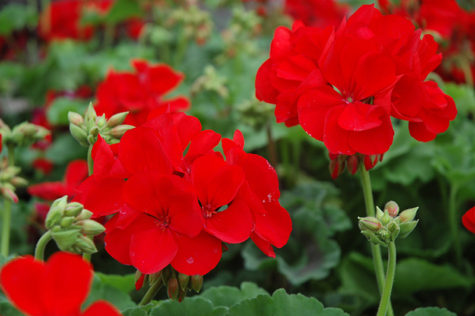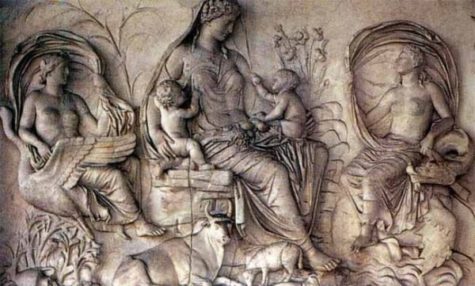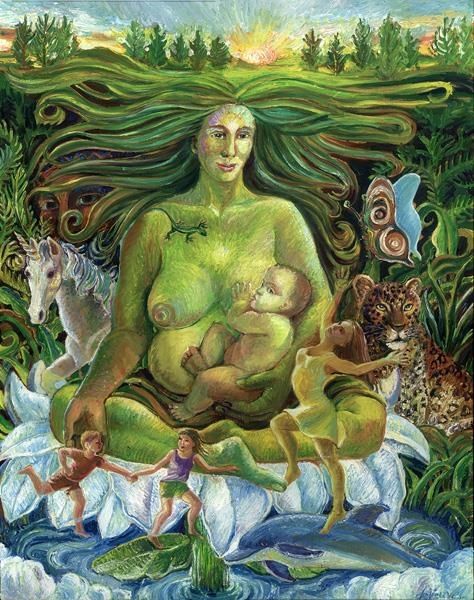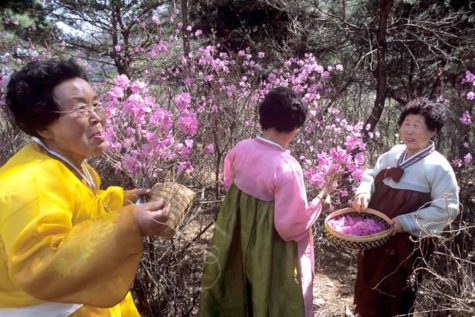Monthly Archives: April 2016
I was unable to find any information on the dates of Geranium day for 2017, and it’s possible that this day is no longer celebrated. The two collection dates for 2016 were Friday 22 April and Friday 20 May 2016.
The English sell geraniums today to collect funds for charities, specifically those that support services for the blind. Since the 1920’s this has been a day in England to collect money for the blind. It represents a joint effort by a number of charities dedicated to helping the blind and is organized by the Greater London Fund for the Blind.
Although at one time real geraniums were given to those who made donations, these days contributors receive a sticker with a red geranium on it. And there are now two collection days—one in the City of London in April and one in the greater London area in May.
The choice of the geranium—a flower without a strong scent—seems unusual as a symbol for the blind, but it may have been chosen simply because the poppy ( see Memorial Day) and the rose ( see Alexandra Rose Day) were already being used for fund-raising purposes. It may also have been chosen for its symbolic meaning.
In the language of flowers, geraniums represent solace – which is what any act of charity stimulates today. It provides hope to those in need. Even if your pocket is empty, extend assistance to someone or something in need. Offer to help an elderly friend with chores, give some returnable bottles to a homeless person, act as a big brother or sister to orphans, give water to a stray cat. Benevolence has many forms, and it makes the world a much nicer place in which to live.
Source: The Free Dictionary
The Eta Aquarids is an above average shower, capable of producing up to 60 meteors per hour at its peak. Most of the activity is seen in the Southern Hemisphere. In the Northern Hemisphere, the rate can reach about 30 meteors per hour. It is produced by dust particles left behind by comet Halley, which has known and observed since ancient times. The shower runs annually from April 19 to May 28. Best viewing will be from a dark location after midnight. Meteors will radiate from the constellation Aquarius, but can appear anywhere in the sky.
Source: SeaSky
The Lyrids is an average shower, usually producing about 20 meteors per hour at its peak. It is produced by dust particles left behind by comet C/1861 G1 Thatcher, which was discovered in 1861. The shower runs annually from April 16-25. These meteors can sometimes produce bright dust trails that last for several seconds. Best viewing will be from a dark location after midnight. Meteors will radiate from the constellation Lyra, but can appear anywhere in the sky.
Source: SeaSky
On April 15th, every year, the Ancient Romans held the festival of Fordicia, also called Hordicidia. This festival was in honor of Tellus, or Terra Mater, the Roman personification of the earth.
Terra Mater or Tellus Mater was a goddess personifying the Earth in Roman mythology, with both names meaning “Mother Earth” (a common metaphorical expression for the Earth and its biosphere as the giver and sustainer of life) in Latin. She was associated with Ceres in respect to growing crops, was responsible for the productivity of farmland, and was also associated with marriage, motherhood, pregnant women, and pregnant animals. Her Greek counterpart is Gaia.
During the festivities, a pregnant cow was sacrificed, the calf fetus burned and the ashes saved for the Parilia festival (an agricultural festival performed annually on April 21). The whole event was governed by the Vestal Virgins and the Pontifex Maximus.
The purpose of the sacrifice was to assure the fertility of the planted grain already growing in the womb of Mother Earth in the guise of Tellus, to whom the sacrifice was offered. As with certain other rituals over which the Vestals presided, the unborn calf is a liminal or mediating being: not yet born, but living; not a full-fledged victim, but sacrificed. The role of the Vestals emphasizes their importance in linking through the ritual reuse of elements the Earth’s fertility, the health and safety of the flocks, and the security of the city, including and especially its military security against invasion.
A similar spring festival in China was witnessed in 1804 by the British ambassador to China, John Barrow. At the temple of Earth, a large porcelain cow was carried in procession then shattered to reveal several small cow-images inside. These were distributed among the people as tokens of a good growing season. Fowler speculated that the Chinese rite was in origin an animal sacrifice similar to that of the Fordicidia.
A Ritual For Tellus Mater
- Color: Green
- Element: Earth
- Offering: Go outside the community and find land to clean up.
- Daily Meal: Vegetarian
Altar: Upon a green cloth place several large stones of different sorts, some in a clay bowl of water; a clay bowl of salt, a loaf of thick, nourishing black bread with herbs and vegetable gratings in it, a chalice of herbal tea, boughs of greenery, and four green candles.
Invocation to Tellus Mater
Our Mother lies beneath our feet
And holds up our every step.
There is nowhere that we can walk
Where She does not lie beneath us.
There is nothing that we can eat
That will nourish our bodies,
Those bodies that are made from Her clay,
That does not come from Her
And Her other children.
We are born of Her
As we are born of woman,
Each and every one of us.
No matter who we are,
No matter where we walk,
No matter what we think,
We are still Her children.
Hail, Mother of All Things!
Hail, bounteous one, giver of life,
And taker of life back into your breast.
From you we all proceed
And to you we shall all return.
Chant:
The Earth is our mother, we must take care of her,
The Earth is our mother, we must take care of her,
Hey and a ho and a ho na na
Hey and a ho and a ho na na
(All join hands while chanting and move in a spiral dance around the room, four times in and out. Then the bread and tea is passed around. It is important that much work be done on the Earth today, both in and out of the community’s land.)
Sources:
Samjinnal is a Korean holiday that falls on March 3 of the lunar calendar. Three being a positive number in numerology, this date containing two threes was considered to be highly auspicious. This festive day announces the arrival of spring. By this time, spring is usually in full bloom – the weather is warm, the young grass is a lively green, and the first flowers are blooming.
Note: Because this holiday is based on the lunar calendar, on Gregorian Calendars the date will vary from year to year. In 2016, this holiday was celebrated on April 9th, in 2017, this holiday falls on March 30.
It is known as the day the swallows came back from Gangnam and the day the snake came out from its winter sleep. It is also the day birds and butterflies start to appear.
Koreans believed that swallows left for their southward journey on ninth day of the ninth lunar month and returned back on Samjinnal. They started to repair their old nests under the eaves or built the new ones to hatch their young.
Many seasonal activities associated with spring took place on this day. Villagers headed out on a blossom tour of the nearby mountains as the gardens were increasingly frequented by butterflies, fresh-green buds became visible on tree branches and the hills and prairies put on their colorful spring dresses.
Popular picnic foods included flower petal pancakes and other seasonal delights. Banquets were also held around this time of year to treat senior members of the community to special meals. For the noblemen across the country, Samjinnal was a day of archery contests.
Flower petal pancakes for the blossom picnic were made with glutinous rice batter, formed in circles, fried in a pan with sesame oil and topped with azalea petals. A special dessert known as hwamyeon was prepared by putting slices of mung-bean dough cakes into omija (favor flavor berries)-scented water, and flavoring it with honey and pine nuts. When preparing the mung bean dough for this dessert, housewives sometimes added azalea petals to it. If they made the dough with honey and dyed it red, the dish would be called sumyeon.
Sumyeon was considered a ritualistic dish as it was frequently used for memorial services.One of the beliefs associated with Samjinnal is that seeing a white butterfly on that day was an ominous sign since white signifies mourning. The sighting of a white butterfly could result in a family member dying during the course of the year.
Tiger or yellow butterflies on the other hand were considered an excellent sign, and portended a lucky year. Women made sure they washed their hair on Samjinnal as they believed it would make their hair vigorous and beautiful throughout the year. Snakes that came out of their hibernation around that time were avoided at all costs since seeing these slithering creatures was regarded as unlucky.
Other names for this holiday:
It was called samjil (삼질) in oldKorean language and referred to as sangsa (상사, 上巳), wonsa (원사, 元巳), sungsam(중삼, 重三), sangje (상제, 上除) or dapcheongjeol (답청절, 踏靑節) in hanja. Samjinnal implies the overlapping of Sam (three). According to Choi Namseon, samjil was derived from the consonants of Samil, and Sangsa is defined as the first snake day of the 3rd lunar month.
Source: Wikipedia and Encyclopedia of Korean Folk Culture
A popular snack all over China, glutinous rice balls (tang yuan) are filled with red bean, sesame, peanut, and other sweet fillings that ooze out from mochi-like dumplings skins. The dumpling skins owe their pleasantly gummy texture to glutinous rice flour, which produces a chewier dough.
You’ll find packets of frozen tang yuan at most Chinese supermarkets, and these days the fillings not only come in the standard assortment, but have branched out into fancy-sounding ones like “sweet osmanthanus” and “chestnut and sesame seed.”
The dough for tang yuan is a simple combination of glutinous rice flour, regular rice flour, and water. Once you get the hang of enclosing the dough around nuggets of sweet filling, you’ll find that making your own tang yuan takes no more than half an hour.
The best part about making your own is that you can experiment with all kinds of nuts and pastes. The filling is a simple combination of sugar, lard, and a filling of nuts and/or beans. Instead of ground peanut or sesame, you can use almonds, cashews, and pecans. (To prepare the nuts: roast them, chop them up, and grind them in a mortar and pestle before mixing with lard and sugar.)
Or, if you’ve always found the red bean filling in supermarket tang yuan to be bland, you can make your own from dried adzuki beans. Coconut flakes are a great addition to fillings of any kind.
You can even vary the fat, substituting coconut oil for the traditional lard. I like to use the lard that I confit with for a filling that’s extra meaty and mildly savory. You could also play around with smoky bacon fat.
Really, you can’t go wrong with the filling. Who would turn down chewy rice balls that release a lava-like concoction that’s sweet, nutty, and porky? Even the water in which tang yuan simmers is surprisingly soothing and tasty to sip between rice ball bites. Make the balls in large batches and freeze them for a quick breakfast or dessert.










